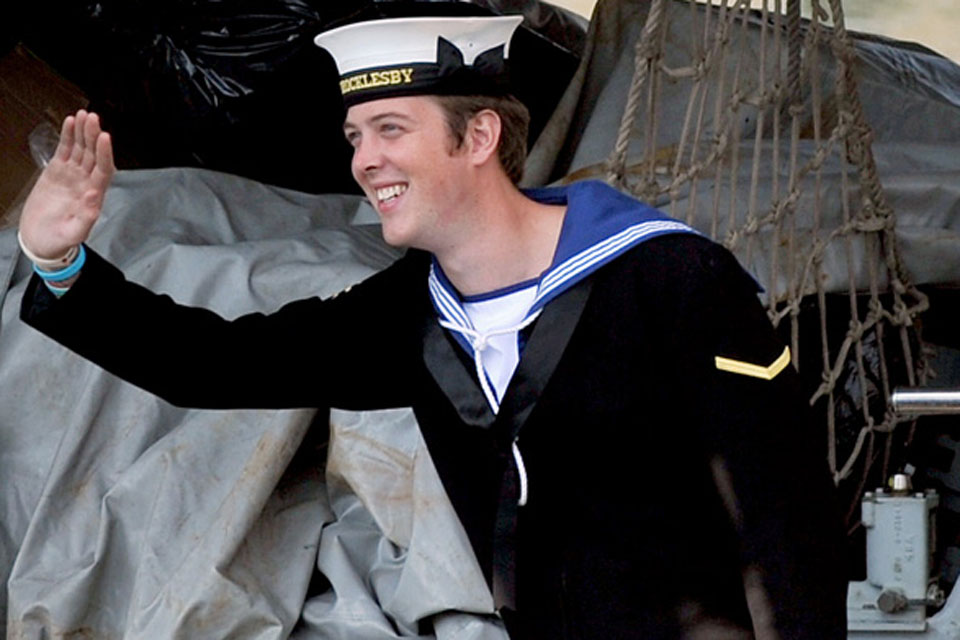HMS Brocklesby returns from Libya mission
Royal Navy minehunter HMS Brocklesby was given a hero's welcome by friends and family yesterday as she returned to Portsmouth Naval Base after five months supporting operations against Libya from the Mediterranean.

The crew of HMS Brocklesby line the decks as the ship returns to Portsmouth Naval Base [Picture: LA(Phot) Jenny Lodge, Crown Copyright/MOD 2011]
HMS Brocklesby sailed into Portsmouth under her own version of the Jolly Roger black flag - a signal that the ship had successfully destroyed enemy targets in Libya, in this case a buoyant mine left by Gaddafi’s forces in a bid to destroy ships carrying humanitarian aid.
Despite the threat of attack from artillery fire, rockets and missiles during her deployment, the minehunter used her sonar and underwater Seafox mine disposal system to locate the mine which had been placed just a mile (1.6km) away from the harbour entrance in Misurata.
HMS Brocklesby’s Commanding Officer, Lieutenant Commander Jim Byron, said:
The Royal Navy has always had a great reputation for mine clearance and it is precisely this type of operation that shows the world just how good we are.
We are extremely proud that we could use our skills and knowledge to open that port and allow humanitarian aid back into Libya where it is so desperately needed. Without this capability there could have been hundreds of lives lost through the detonation of that mine.
I am so proud of my team - they just got on and did their business and they did it really, really well.

A sailor onboard HMS Brocklesby waves to his family waiting on the jetty [Picture: LA(Phot) Jenny Lodge, Crown Copyright/MOD 2011]
Initially deployed as part of Standing NATO Mine Countermeasures Group 1 in January 2011, a group of minehunters which stand ready to react to world events, HMS Brocklesby was retasked to Operation UNIFIED PROTECTOR and Operation ELLAMY off the coast of Libya.
At the end of April 2011 HMS Brocklesby began clearing the port of Misurata of mines after NATO forces spotted pro-Gaddafi forces laying the explosive devices.
The minehunter then stayed in the harbour area for a further six days in range of hostile troops to continue searching for any further mines that would stop vital aid from reaching Libyan citizens.
The MV Red Star was the first to enter the port following the clearance operation, and, despite the artillery rounds being fired in the port, she picked up more than 700 civilians injured during the conflict.
Commander-in-Chief Fleet, Admiral Sir Trevor Soar, sailed out to meet HMS Brocklesby as she sailed home, calling her the ‘jewel in the crown of operations in Libya’:
I wanted to pay tribute and say how proud I am of the effort and professionalism the ship’s company has demonstrated over the past 155 days,” he said. “Brocklesby originally sailed to work with NATO on a series of exercises but was quickly retasked, showing the flexibility and determination of our personnel; all of them have done exceedingly well.
This was the first time that a Royal Navy minehunter has been involved in live mine clearance operations within range of hostile artillery and rockets since the campaign off the Al Faw peninsula in 2003, during the second Gulf War, when it saw the first operational use of the Seafox mine disposal system against live ordnance during conflict.
HMS Brocklesby spent her last few weeks patrolling and minehunting in the waters off the Misurata coastline as the threat of mines and waterborne IEDs remains high. With the port open again there are plenty of ships sailing in and out so it was important for the crew to make sure the waters were free of explosives.
HMS Brocklesby has now handed her duties over to Faslane-based HMS Bangor.